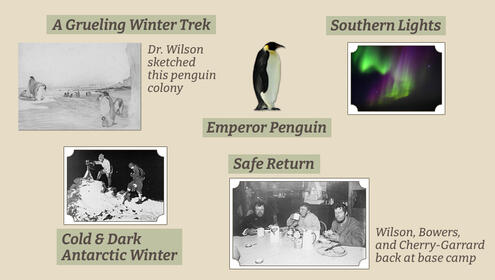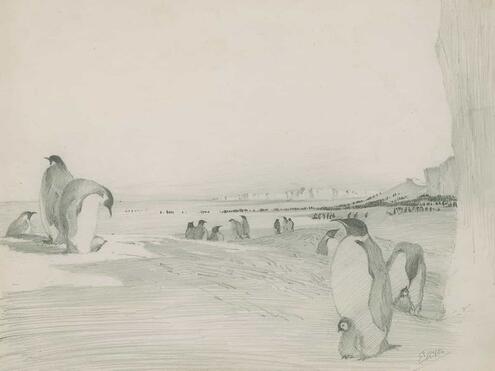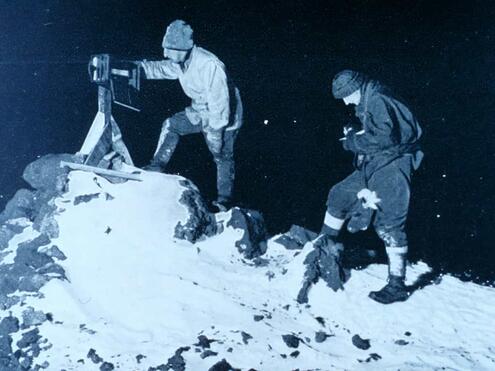
Click the (+) signs to explore the items in my scrapbook.



Dr. Wilson sketched this penguin colony
A Grueling Winter Trek
In June 1911, in the middle of the long, dark winter, three members of the British team set out on a grueling trek. Their mission: to collect emperor penguin eggs. Dr. Edward Wilson studied the eggs to find out if birds and reptiles are related.

Cold & Dark Antarctic Winter
For five long weeks, the men traveled day and night in winter darkness and bitter cold. Here, Dr. Edward Wilson and Henry “Birdie” Bowers read a thermometer. They recorded temperatures as low as -60.9℃ (-77.5℉)!

Emperor Penguin
Did you know that the emperor penguin (Aptenodytes forsteri) is the largest penguin alive today? It stands about 1 meter (3 feet) tall and weighs up to 35 kg (77 lbs). They breed in winter, so that by the summer the chicks will be big enough to head to sea.

Southern Lights
Along the way, the team saw colorful lights swirling through the sky. This brilliant display is called the aurora australis, or southern lights. These majestic “light shows” are best seen near the Poles. In the North Pole, it is called the aurora borealis.

Southern Lights
Along the way, the team saw colorful lights swirling through the sky. This brilliant display is called the aurora australis, or southern lights. These majestic “light shows” are best seen near the Poles. In the North Pole, it is called the aurora borealis.

Wilson, Bowers, and Cherry-Garrard back at base camp
Safe Return
The barely survived the brutal trek. Blizzards blew for days. The team even lost their tent in one storm but fortunately found it the next day. After five weeks, they finally returned to base camp. They were exhausted, frostbitten, and “clothed in an armor of ice.”
Image Credits:
penguins drawing and safe return, © Scott Polar Research Institute; emperor penguin, © US Antarctic Program; temperature reading, courtesy of NOAA; aurora australis, © NSF.




 Biodiversity
Biodiversity
 Brain
Brain
 Genetics
Genetics
 Marine BiOLogy
Marine BiOLogy
 MicrobiOLogy
MicrobiOLogy
 PaleontOLogy
PaleontOLogy
 ZoOLogy
ZoOLogy
 AnthropOLogy
AnthropOLogy
 ArchaeOLogy
ArchaeOLogy
 Astronomy
Astronomy
 Climate Change
Climate Change
 Earth
Earth
 Physics
Physics
 Water
Water

